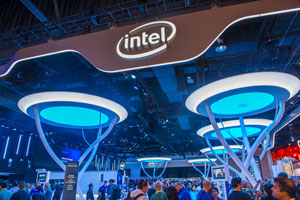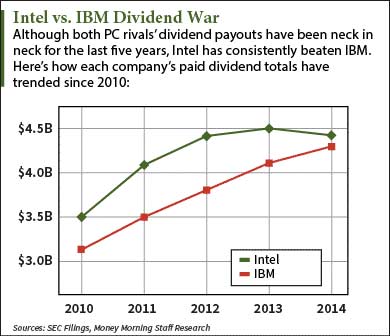 Intel Corp. (Nasdaq: INTC) has pioneered the semiconductor industry for more than 46 years - but it's also pioneered tech into becoming a dividend-friendly sector. The INTC dividend has been rewarding investors for 23 years, paving the way for many other tech titans.
Intel Corp. (Nasdaq: INTC) has pioneered the semiconductor industry for more than 46 years - but it's also pioneered tech into becoming a dividend-friendly sector. The INTC dividend has been rewarding investors for 23 years, paving the way for many other tech titans.
The tech sector used to be devoid of dividend stocks. CNBC reported that there were only 22 dividend-paying IT stocks on the S&P 500 in December 2003. By last July, that number more than doubled to 45.
But the sector can be tricky for dividend investors since it's packed with high-growth operations that invest in growth instead of returning cash to shareholders. Older companies with a history of dividend increases, like Intel, are the best picks in a sector that never stops expanding.
Here's how the INTC dividend has stacked up over the years...
The INTC Dividend Leads the Tech Sector
Intel has delivered a constant stream of quarterly payouts since starting its dividend policy in 1992. Its 29% compound annual growth rate has made it one of the most mature dividend tech plays on the market.
But that's not to say the semiconductor king didn't have periods of stagnation. Intel's dividend remained unchanged at $0.02 per share for 14 straight quarters between 2000 and mid-2003. The company saw it as a measure to save cash after the dot-com bubble burst.
Intel bounced back in 2004 by doubling its quarterly payouts to $0.04 a share. Over the last decade, Intel's quarterly dividend has tripled from $0.08 to $0.24. The most recent hike was declared on Feb. 4.
 The company isn't expected to cut back on its boosts anytime soon. Jefferies analyst Mark Lipacis said in September that Intel is the semiconductor industry's "next dividend growth story" and predicted its dividend could soar as much as 45% by 2016.
The company isn't expected to cut back on its boosts anytime soon. Jefferies analyst Mark Lipacis said in September that Intel is the semiconductor industry's "next dividend growth story" and predicted its dividend could soar as much as 45% by 2016.
The best part of the INTC dividend is that its payout ratio is only 45%. That's lower than five of the top 10 dividend-paying companies on the S&P 500, including Verizon Communications Inc. (NYSE: VZ) at 89.3% and Johnson & Johnson (NYSE: JNJ) at 48.4%.
Intel has increased its dividend every year for the last 11 years. At that rate, it's well on its way to joining the "Dividend Aristocrats" - companies on the S&P 500 who have increased their dividends for at least 25 consecutive years. Intel already meets the club's other qualifications, including a minimum market cap of $3 billion and an average trading volume of at least $5 million.
Intel's dividend has surpassed many tech giants by a considerable margin over the last few years - most notably International Business Machines Corp. (NYSE: IBM).
IBM is the only software company to come close to Intel's payouts. IBM has seen a 22.9% increase in total annual paid dividends between 2011 and 2014. That greatly overshadows Intel's 7.3% increase over the same period.
However, Intel has dished out more cash every year. The largest disparities were in 2011 and 2012, when Intel paid $600 million more than IBM.
Now for the big question...
With a Juicy Dividend, Is Intel Stock a Buy?
The INTC dividend is just one of the reasons to buy Intel. According to Money Morning Defense & Tech Specialist Michael A. Robinson, Intel is one of the best tech stocks on the market - and the INTC dividend is poised to keep growing alongside the company's surging profit streams.
Its recent revenue numbers are the highest in company history. It posted a full-year revenue of $55.9 billion in 2014, marking a 6.1% year-over-year increase. In its Q4 earnings report, Intel saw $14.7 billion in revenue, up from Q3's $14.6 billion. The company's earnings per share rose 12.1% from Q3 to $0.74.
[epom key="ddec3ef33420ef7c9964a4695c349764" redirect="" sourceid="" imported="false"]
The company's continued growth is tied to two areas - Vietnam and the auto industry.
Intel has had a stake in Vietnam's tech market for almost a decade now. It started producing chips there back in 2006 with an investment of $300 million. By 2007, it had more than tripled that amount to $1 billion.
Intel's production in Vietnam has exponentially grown since then. Last year, its chips constituted a staggering $1.8 billion in exports. Intel takes advantage of Vietnam's cheap labor costs and proximity to China, which gives the company easy access to the world's largest market.
Then, there are the cars.
Technology is merging with the car industry at an exciting pace. IHS researchers report the car industry is boosting huge sales of semiconductors. Sales of automotive chips grew 10% to $29 billion in 2014.
And of all the chip companies with auto clients, Intel rises above the pack with its list of big-name customers. Intel's key customers include BMW AG, Hyundai Motor Co. Ltd. (OTCMKTS: HYMLF), and Nissan Motor Co. Ltd. (OTCMKTS: NSANY).
"This shows that Intel is absolutely committed to remaining at the forefront of chip technology," Robinson noted. "Moreover, it shows how quickly Intel is changing its focus after years of depending on sales of chips for personal computers."
The company is also rumored to buy out fellow chipmaker Altera Corp. (Nasdaq: ALTR) for $13 billion. The deal would be Intel's biggest ever and fits into the company's initiatives to go after the growing wearable tech and Big Data markets.
Intel stock has traded up 22.8% in the last year. Its dividend yield is 3.1% as of March 30 and analysts estimate 12.1% growth within the next year.
The Tech Industry Has Never Been More Exciting for Investors... In 2014, our Tech Expert Michael A. Robinson covered more than 100 ways to make huge profits from tech stocks. And he'll share a lot more tech investing ideas this year. But first, he answers some of your biggest and most important questions about investing in tech...
Follow me on Twitter: @AlexMcGuire92
Related Articles:


